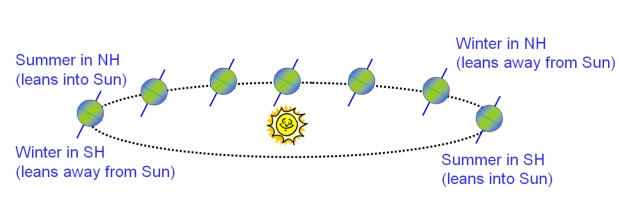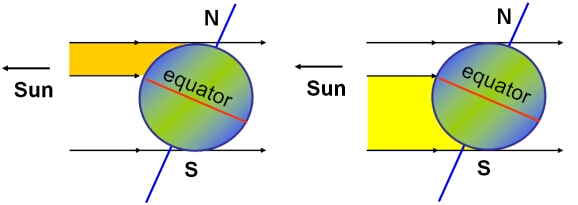Seasons
Throughout the year, most places on Earth go through four noticeable seasons: Summer, Autumn (Fall), Winter and Spring, each lasting about three months. The seasons experienced by the northern and southern hemispheres always differ by six months. When it is Summer in the northern hemisphere, it is Winter in the southern hemisphere, and vice-versa.
Seasons are a direct consequence of the Earth’s tilted rotation axis, which makes an angle about 23.5 degrees to a line drawn perpendicular to the plane of the ecliptic. The direction of the Earth’s rotation axis stays nearly fixed throughout one orbit so that at different parts of the orbit, one hemisphere ‘leans’ towards the Sun (Summer), while the other ‘leans’ away (Winter). Six months later, the Earth is leaning in the opposite direction towards the Sun.

For locations north or south of the equator, the main feature accompanying each season is a change in temperature caused by the varying amount of sunlight that falls on each hemisphere of the Earth throughout its annual orbit. The hemisphere tilted towards the Sun will experience extended hours of sunlight and more direct sunlight.

As the Sun is higher in the sky during Summer, the sunlight reaching the surface is more concentrated. In Winter, the Sun is lower in the sky, and sunlight is spread out over a larger area. During Spring and Autumn, both hemispheres receive about the same amount of sunlight.
At the equator, the temperature variation is much smaller throughout the year, and it is common to consider just two seasons: dry and wet (or monsoon). For observers right at the North Pole and the South Pole, there are only two seasons – a practically six-month-long Winter night followed by an almost six-month-long Summer day! Within the Arctic Circle and the Antarctic Circle (latitudes 66.5 degrees north and south, 90-23.5=66.5 degrees), there will be at least one polar day (24 hours of continuous daylight, sometimes called the ‘midnight sun’) and one polar night (24 continuous hours of darkness).
The start date of the seasons is often chosen as the dates of the solstices (Summer and Winter) and equinoxes (Autumn and Spring). Alternatively, the start of a new season may be associated with the first day of the month (December, March, June and September) in which a solstice or equinox occurs.
The Earth’s changing distance from the Sun, due to the Earth’s elliptical orbit, is sometimes thought to cause the seasons. This is incorrect! The Earth’s distance from the Sun varies by about 3% from the closest approach (perihelion distance = 147.09 million km) to the furthest approach (aphelion distance = 152.10 million km). This small change in distance does not account for the temperature differences between Summer and Winter, and does not explain how it can be Winter in one hemisphere and Summer in the other hemisphere.
Study Astronomy Online at Swinburne University
All material is © Swinburne University of Technology except where indicated.

